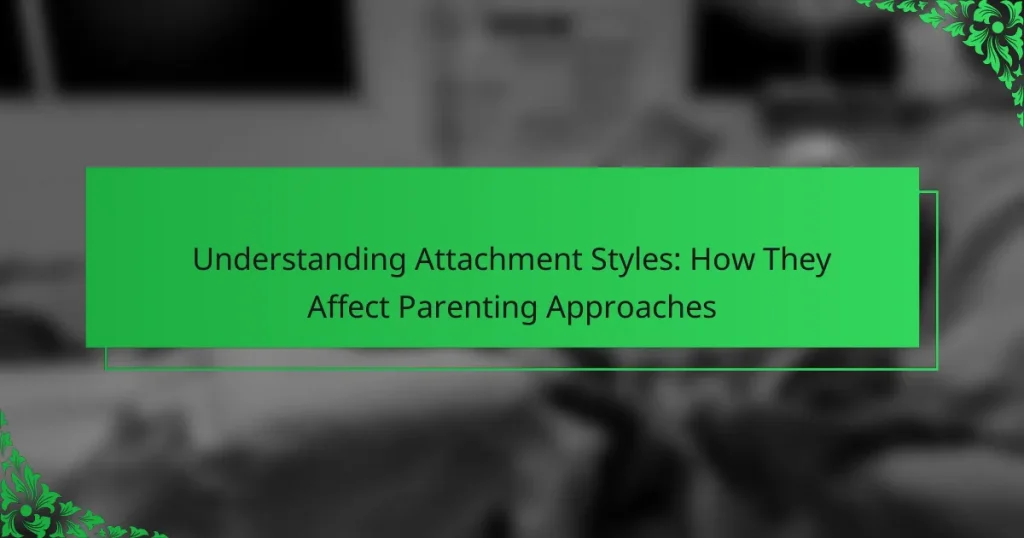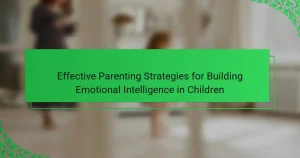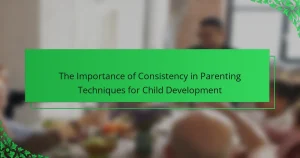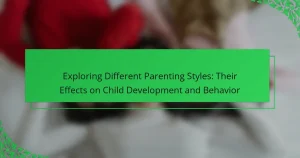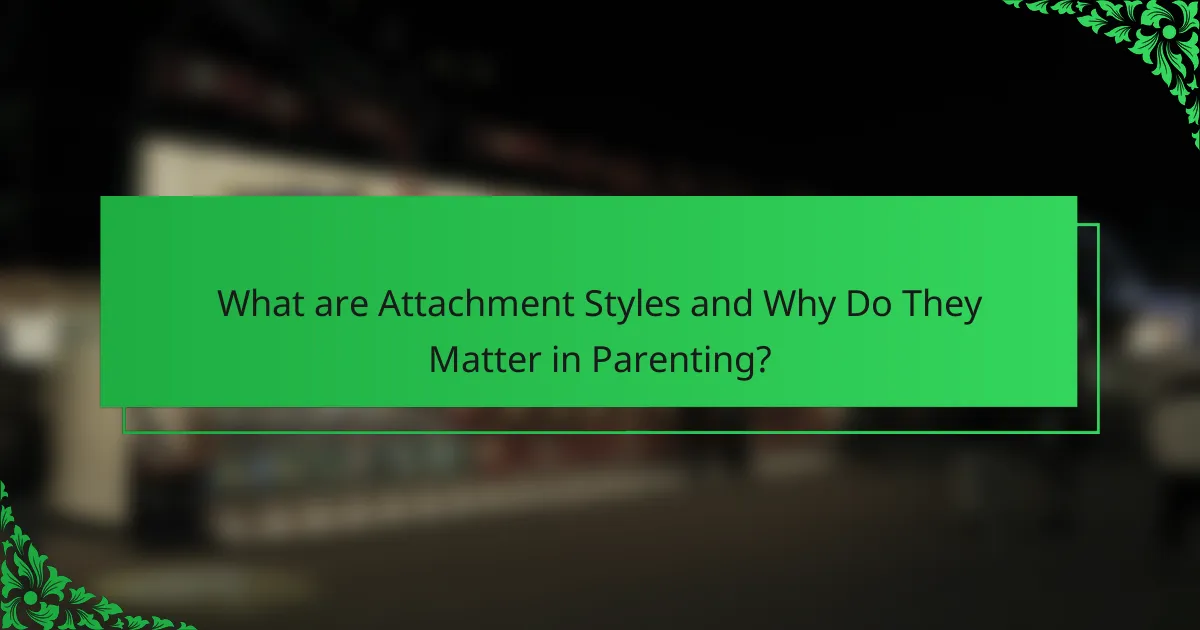
What are Attachment Styles and Why Do They Matter in Parenting?
Attachment styles are patterns of relating to others that develop in early childhood. They are classified into four main types: secure, anxious, avoidant, and disorganized. Each style influences how individuals interact in relationships throughout their lives. In parenting, attachment styles matter significantly because they affect how parents respond to their children’s needs.
Secure attachment promotes responsive and nurturing behavior. Anxious attachment may lead to over-involvement or inconsistency in caregiving. Avoidant attachment can result in emotional distance and neglect. Disorganized attachment often creates confusion and unpredictability in parenting.
Research shows that secure attachment in childhood is linked to better emotional regulation and social skills later in life. Conversely, insecure attachment styles can contribute to behavioral issues and difficulties in relationships. Understanding these styles helps parents foster healthier connections with their children, impacting their overall development positively.
How do different attachment styles influence parenting approaches?
Different attachment styles significantly influence parenting approaches. Secure attachment leads to responsive and nurturing parenting. Parents with secure attachment are more likely to provide emotional support and stability. In contrast, anxious attachment often results in overprotective or inconsistent parenting. These parents may struggle with setting boundaries. Avoidant attachment tends to create distant or disengaged parenting styles. Such parents may prioritize independence over emotional connection. Research shows that these attachment styles shape children’s emotional development and behavior. A study by Mikulincer and Shaver (2007) highlights the long-term effects of attachment on parenting.
What are the key characteristics of secure attachment in parenting?
Key characteristics of secure attachment in parenting include responsiveness, consistency, and emotional availability. Responsive parents promptly meet their child’s needs, fostering trust. Consistency in parenting behavior provides children with a sense of security. Emotionally available parents offer support and validation, encouraging open communication. Research shows that children with secure attachments are more likely to develop healthy relationships and emotional regulation skills. A study by Ainsworth et al. (1978) demonstrated that securely attached children felt safe to explore their environment, indicating the importance of these characteristics in parenting.
How does anxious attachment affect parenting behaviors?
Anxious attachment significantly impacts parenting behaviors. Parents with anxious attachment often exhibit heightened sensitivity to their children’s needs. They may respond excessively to perceived threats or distress in their children. This can lead to overprotective or intrusive parenting styles. Such behaviors stem from their own fears of abandonment and rejection. Research indicates that children of anxious parents may experience increased anxiety themselves. This cycle can perpetuate patterns of anxious attachment across generations. Studies show that these parenting behaviors can hinder a child’s emotional regulation and independence.
What impact does avoidant attachment have on parenting styles?
Avoidant attachment significantly influences parenting styles. Parents with avoidant attachment tend to be emotionally distant. They may struggle to provide warmth and affection. This can lead to a lack of responsiveness to children’s emotional needs. Research indicates that children of avoidant parents may develop similar attachment styles. These children often exhibit increased anxiety and difficulty forming relationships. A study by Mikulincer and Shaver (2007) highlights these dynamics. The findings suggest that avoidant parents may prioritize independence over emotional connection. Thus, avoidant attachment can create a cycle of emotional detachment in parenting.
Why is understanding attachment styles important for parents?
Understanding attachment styles is crucial for parents because it influences their child’s emotional development. Attachment styles determine how children relate to others and form relationships. Secure attachment fosters healthy social skills and emotional regulation. In contrast, insecure attachment can lead to anxiety and behavioral issues. Research shows that children with secure attachments tend to perform better academically and socially. Parents who understand these styles can adapt their parenting strategies accordingly. This knowledge helps in creating a nurturing environment that promotes secure attachments. By recognizing their own attachment styles, parents can break negative cycles and improve family dynamics.
How can knowledge of attachment styles improve parent-child relationships?
Knowledge of attachment styles can significantly improve parent-child relationships. Understanding these styles helps parents identify their own attachment behaviors. It also allows them to recognize their child’s attachment needs. Secure attachment promotes trust and emotional safety. Parents who understand attachment styles can respond more effectively to their child’s emotions. This responsiveness fosters a deeper connection. Research shows that secure attachments lead to better social and emotional outcomes for children. For example, children with secure attachments are more likely to develop healthy relationships later in life.
What role do attachment styles play in a child’s emotional development?
Attachment styles significantly influence a child’s emotional development. They shape how children relate to others and manage their emotions. Secure attachment fosters healthy relationships and emotional regulation. Insecure attachment can lead to anxiety and difficulties in social interactions. Research indicates that children with secure attachment demonstrate better emotional resilience. They are more likely to express their feelings openly. Conversely, those with insecure attachment may struggle with trust and emotional expression. A study by Ainsworth et al. (1978) highlights the long-term impact of attachment styles on emotional health. Securely attached children often exhibit greater self-esteem and social competence.

What are the Different Types of Attachment Styles?
There are four main types of attachment styles: secure, anxious, avoidant, and disorganized. Secure attachment is characterized by comfort with intimacy and independence. Anxious attachment involves a preoccupation with relationships and fear of abandonment. Avoidant attachment is marked by a reluctance to rely on others and emotional distance. Disorganized attachment combines elements of both anxious and avoidant styles, leading to confusion in relationships. Research by Mary Ainsworth in the Strange Situation experiment supports these classifications. Ainsworth’s findings show that these styles emerge from early interactions with caregivers and significantly impact later relationships.
What are the four main attachment styles identified in psychology?
The four main attachment styles identified in psychology are secure, anxious, avoidant, and disorganized. Secure attachment is characterized by comfort with intimacy and independence. Anxious attachment involves a preoccupation with relationships and fear of abandonment. Avoidant attachment is marked by discomfort with closeness and a preference for emotional distance. Disorganized attachment combines elements of both anxious and avoidant styles, often resulting from inconsistent caregiving. These styles are based on the work of John Bowlby and Mary Ainsworth, foundational figures in attachment theory. Their research demonstrated how early interactions with caregivers shape emotional and relational patterns throughout life.
How does secure attachment differ from anxious attachment?
Secure attachment is characterized by a strong sense of trust and comfort in relationships. Individuals with secure attachment feel safe and valued, leading to healthier interpersonal dynamics. In contrast, anxious attachment involves a heightened sensitivity to the availability and responsiveness of others. Those with anxious attachment often experience fear of abandonment and may exhibit clingy or overly dependent behaviors.
Research indicates that secure attachment fosters positive emotional regulation and effective communication. In contrast, anxious attachment can lead to increased anxiety and conflict in relationships. Studies show that securely attached individuals are more likely to have stable and satisfying relationships. Anxiously attached individuals may struggle with jealousy and insecurity in their connections.
What are the traits of avoidant attachment compared to disorganized attachment?
Avoidant attachment is characterized by a strong desire for independence and a reluctance to rely on others. Individuals with avoidant attachment often suppress their emotions and avoid closeness in relationships. They tend to view intimacy as a threat and prefer to maintain distance from emotional connections.
In contrast, disorganized attachment is marked by a lack of clear attachment behavior. Individuals with disorganized attachment may exhibit contradictory behaviors, such as seeking comfort and then withdrawing. They often struggle with fear and anxiety regarding relationships, stemming from inconsistent caregiving in childhood.
Research indicates that avoidant attachment leads to difficulties in emotional expression and relationship satisfaction. Disorganized attachment, however, is linked to higher levels of anxiety and confusion in interpersonal relationships. These distinctions highlight the varying impacts of attachment styles on emotional and relational functioning.
How can parents identify their own attachment style?
Parents can identify their own attachment style through self-reflection and assessment. They can start by examining their childhood experiences with caregivers. Understanding how those experiences shaped their emotional responses is crucial. Parents should also consider their current relationships and how they interact with their children. Observing patterns in their behavior, such as responsiveness or avoidance, can provide insights. Additionally, taking validated attachment style quizzes can offer structured guidance. Research indicates that awareness of one’s attachment style can improve parenting practices. Recognizing their style helps parents foster healthier relationships with their children.
What questions can help individuals assess their attachment style?
To assess attachment style, individuals can ask specific questions about their relationship behaviors. These questions may include: “Do I feel comfortable relying on others?” and “How do I react when my partner expresses affection?” Individuals might also consider, “Do I often worry about my partner leaving me?” Another question could be, “Do I find it hard to get close to others?” Research indicates that these inquiries can reveal patterns of attachment behaviors. For instance, studies show that anxious individuals often fear abandonment, while avoidant individuals may struggle with intimacy. This structured approach helps individuals identify their attachment styles effectively.
How does self-awareness of attachment styles benefit parenting?
Self-awareness of attachment styles benefits parenting by enabling parents to understand their emotional responses. This awareness helps parents recognize how their upbringing influences their interactions with children. It allows for more mindful responses to a child’s needs. Parents can then model healthier attachment behaviors. Research shows that secure attachment in parents leads to secure attachment in children. A study by Mikulincer and Shaver (2007) found that parents with secure attachment styles are more sensitive and responsive. This results in better emotional regulation in children. Ultimately, self-awareness fosters a nurturing environment for healthy child development.

How Can Parents Adapt Their Approaches Based on Attachment Styles?
Parents can adapt their approaches based on attachment styles by recognizing their child’s specific needs. For secure attachment, parents should provide consistent support and encouragement. This fosters a sense of safety and confidence in children. For anxious attachment, parents should offer reassurance and be more emotionally available. This helps reduce anxiety and builds trust. For avoidant attachment, parents should respect the child’s need for independence while gently encouraging emotional expression. This approach balances autonomy with connection. Research indicates that responsive parenting improves attachment security, leading to better emotional regulation in children. Understanding these styles allows parents to tailor their interactions effectively.
What strategies can parents use to foster secure attachment?
Parents can foster secure attachment by consistently responding to their child’s needs. This includes being emotionally available and attentive. Parents should engage in positive interactions, such as playing and talking with their child. Physical affection, like hugging and cuddling, also strengthens the bond. Establishing routines provides a sense of safety and predictability. Parents should encourage exploration while being a safe base for their child. Active listening and validating feelings help children feel understood. Research shows that secure attachment leads to better emotional regulation and social skills later in life.
How can consistent communication enhance attachment security?
Consistent communication enhances attachment security by fostering trust and predictability in relationships. When individuals communicate regularly, they share thoughts and feelings openly. This openness reduces anxiety and uncertainty about the relationship. Research indicates that secure attachment is linked to effective communication patterns. For instance, a study by Mikulincer and Shaver (2007) found that consistent communication strengthens emotional bonds. This emotional connection leads to greater relationship satisfaction and security. Furthermore, consistent communication allows for conflict resolution, which is essential for maintaining healthy attachments. Overall, regular communication is crucial for developing and sustaining attachment security.
What role does emotional availability play in developing secure attachment?
Emotional availability is crucial for developing secure attachment. It refers to a caregiver’s ability to be responsive and emotionally present. When caregivers are emotionally available, they create a safe environment for children. This safety fosters trust and encourages children to explore their surroundings. Research indicates that children with emotionally available caregivers are more likely to develop secure attachment styles. A study by Ainsworth et al. (1978) found that responsive caregiving leads to secure attachment in infants. These infants tend to exhibit healthier emotional regulation and social skills later in life. Thus, emotional availability directly influences the formation of secure attachment.
What common challenges do parents face related to their attachment styles?
Parents often face challenges such as insecurity, anxiety, and difficulty in emotional regulation due to their attachment styles. Insecure attachment can lead to overprotectiveness, as parents may fear their child will experience the same abandonment they did. This can hinder the child’s independence and self-esteem. Anxious attachment may cause parents to be overly reactive to their child’s needs, resulting in inconsistency in parenting. Avoidant attachment can lead to emotional distance, making it difficult for parents to connect with their children. Research indicates that these attachment styles directly influence parenting behaviors and the emotional environment of the home, impacting children’s development and relationships.
How can parents overcome the effects of their own attachment history?
Parents can overcome the effects of their own attachment history by actively seeking therapy or counseling. Therapy helps parents understand their attachment styles and their impact on parenting. Engaging in self-reflection allows parents to recognize their emotional triggers. Developing secure attachment with their children is crucial. Parents can practice responsive parenting by being attuned to their child’s needs. Building a support network can provide additional emotional resources. Research indicates that therapy can significantly improve parenting outcomes. A study by Mikulincer and Shaver (2007) highlights the benefits of secure attachment in parenting.
What resources are available for parents seeking to improve their attachment styles?
Books on attachment theory are valuable resources for parents. “The Attachment Parenting Book” by Dr. William Sears offers practical advice. “Attached” by Amir Levine and Rachel Heller provides insights into [censured] attachment styles. Online courses on platforms like Coursera and Udemy cover attachment styles in parenting. Support groups, both in-person and online, facilitate discussions among parents. Therapy sessions with licensed professionals can help address attachment issues. Websites like the Attachment Parenting International offer articles and community support. Parenting workshops often include attachment-focused content for practical applications.
What practical tips can parents implement to support healthy attachment in their children?
Parents can support healthy attachment in their children by consistently responding to their needs. This means being available emotionally and physically when children seek comfort or assistance. Engaging in regular, meaningful interactions fosters connection. Activities like reading together or playing can enhance bonding. Providing a safe and predictable environment helps children feel secure. Encouraging open communication allows children to express their feelings. Demonstrating affection through hugs and praise strengthens the emotional bond. Finally, modeling healthy relationships teaches children about trust and connection. Research indicates that these practices contribute positively to children’s emotional development and attachment security.
Attachment styles are identifiable patterns of relating to others that emerge in early childhood, classified into secure, anxious, avoidant, and disorganized types. These styles significantly influence parenting approaches, affecting how parents respond to their children’s emotional needs and shaping children’s emotional development and relationship skills. The article explores the characteristics of each attachment style, their impact on parenting behaviors, and strategies for fostering secure attachments in children. Additionally, it highlights the importance of self-awareness in parents regarding their attachment styles and offers resources for improving parenting practices. Understanding attachment styles is essential for creating nurturing environments that promote healthy emotional development in children.
